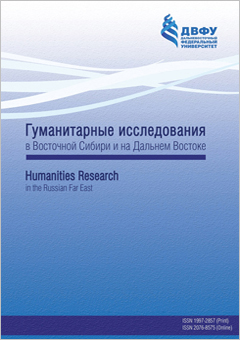Понимание причинно-следственных связей как ключевой навык человека говорящего
DOI:
https://doi.org/10.24866/1997-2857/2023-1/112-122Ключевые слова:
язык, коммуникация, орудия труда, рекурсия, причинно‑следственные связи, префронтальные формации, рабочая память, зеркальные нейроныАннотация
В статье анализируется способность людей к пониманию причинно‑следственных связей и отмечается фундаментальная роль данного когнитивного навыка в овладении членораздельной речью. Автор подчеркивает взаимосвязь между орудийной деятельностью, разворачивающейся в определенном социальном контексте, энцефализацией в линии гоминид, развитием лобных долей головного мозга человека (в частности, префронтальных формаций коры) и совершенствованием концептуальной основы производства орудий труда. В совокупности отмеченные феномены связаны с увеличением емкости кратковременного компонента рабочей памяти, позволяющей человеку одновременно удерживать внимание на нескольких объектах и связях между ними, осуществлять рекурсивные действия, согласованно оперировать несколькими понятиями, генерируя рекурсивные предложения. Ввиду реализации перечисленных процессов у человека возникает способность понимать каузальные зависимости и умение выстраивать, анализировать и понимать предложения, состоящие из нескольких слов, а также создавать и понимать правила их построения.
Скачивания
Библиографические ссылки
Аристотель. Метафизика. М.; Л.: Соцэкгиз, 1934.
Ахутина Т.В. Нейролингвистический анализ лексики, семантики и прагматики. М.: Языки славянских культур, 2014.
Бернштейн Н.А. Очерки по физиологии движений и физиологии активности. М.: Медицина, 1966.
Бурлак С.А. Происхождение языка. Факты, исследования, гипотезы. М.: Альпина Паблишер, 2019.
Вригт Г.Х. Логико-философские исследования: избранные труды. М.: Прогресс, 1986.
Дубынин В.А. Мозг и зеркальные нейроны // «ПостНаука». URL: https://postnauka.ru/video/89453
Емельянов-Ярославский Л.Б. Интеллектуальная квазибиологическая система. Индуктивный автомат. М.: Наука, 1990.
Ивин А.А. Логика причинности // Гуманитарный портал. URL: https://gtmarket.ru/concepts/6965
Касавин И.Т. Дэвид Юм: парадоксы познания // Вопросы философии. 2011. № 5. C. 157–171.
Кольцова М.М. Двигательная активность и развитие функций мозга ребенка: роль двигательного анализатора в формировании высшей нервной деятельности ребенка. М.: Педагогика, 1973.
Котов А.А. Каузальное мышление у экспертов и новичков // Когнитивная психология: феномены и проблемы. М.: ЛЕНАНД, 2014. С. 87–107.
Леонтьев А.Н. Деятельность. Сознание. Личность. М.: Политиздат, 1975.
Лурия А.Р. Лекции по общей психологии. СПб.: Питер, 2006.
Лурия А.Р. Мозг человека и психические процессы: в 2-х т. Т. 2. Нейропсихологический анализ сознательной деятельности. М.: Педагогика, 1970.
Лурия А.Р. О генезисе произвольных движений // Вопросы психологии. 1957. № 2. С. 65–67.
Лурия А.Р. Основы нейропсихологии: учебное пособие. М.: Академия, 2013.
Лурия А.Р. Язык и сознание. М.: Изд-во Мос. ун-та, 1979.
Поршнев Б.Ф. О начале человеческой истории. М.: Мысль, 1974.
Риццолатти Дж., Синигалья К. Зеркала в мозге: О механизмах совместного действия и сопереживания. М.: Языки славянских культур, 2012.
Сергин В.Я., Сергин А.В. Иерархическая модель восприятия без комбинаторного взрыва // Журнал высшей нервной деятельности. 2019. Т. 69. № 5. С. 629–654.
Социальная философия и философия истории: учебное пособие. М.: ИНФРА-М, 2018.
Энгельс Ф. Роль труда в процессе превращения обезьяны в человека // Маркс К., Энгельс Ф. Сочинения. Т. 20. М.: Государственное издательство политической литературы, 1961. С. 486–499.
Aboitiz, F., García, R.R., Bosman, C. and Brunetti, E., 2006. Cortical memory mechanisms and language origins. Brain and Language, Vol. 98, no. 1, pp. 40–56.
Arbib, M.A., 2005. The mirror system hypothesis: How did protolanguage evolve? In: Tallerman, M. ed., 2005. Language origins: perspectives on evolution. Oxford: Oxford University Press, pp. 21–47.
Arbib, M.A., Bonaiuto, J. and Rosta, E., 2006. The mirror system hypothesis: From a macaque-like mirror system to imitation. In: Cangelosi, A., Smith, A.D.M. and Smith, K. eds., 2006. Proceedings of the 6th Evolution of language conference (EVOLANG6). Singapore: World Scientific, pp. 3–10.
Baddeley, A.D., 2000. The episodic buffer: A new component of working memory? Trends in Cognitive Sciences, Vol. 4, no. 11, pp. 417–423.
Baddeley, A.D., 2007. Working memory, thought and action. Oxford: Oxford University Press.
Baddeley, A.D. and Hitch, G.J., 1974. Working memory. In: Bower, G.A. ed., 1974. Recent advances in learning and motivation. Vol. 8. New York: Academic Press, pp. 47–89.
Calvin, W.H. and Bickerton, D., 2000. Lingua ex machina: Reconciling Darwin and Chomsky with the human brain. Cambridge: MIT Press.
Deacon, T., 1997. The symbolic species: The co-evolution of language and the brain. New York; London: W.W. Norton & Co.
Heyes, С., 2010. Where do mirror neurons come from? Neuroscience & Biobehavioral Reviews, Vol. 34, no. 4, pp. 575–583.
Jacobs, B., Schall, M. and Scheibel, A.B., 1993. A quantitative dendritic analysis of Wernicke’s area in humans. II. Gender, hemispheric, and environmental factors. The Journal of Comparative Neurology, Vol. 327, no. 1, pp. 97–111.
Ramachandran, V.S., 2000. Mirror neurons and imitation learning as the driving force behind the great leap forward in human evolution. URL: https://www.edge.org/conversation/vilayanur_ramachandran-mirror-neurons-and-imitation-learning-as-the-driving-force
Read, D.W., 2008. Working memory: a cognitive limit to non-human primate recursive thinking prior to hominid evolution. Evolutionary Psychology, Vol. 6, no. 4, pp. 676–714.
Tomasello, M., 2020. The role of roles in uniquely human cognition and sociality. Journal for the Theory of Social Behaviour, Vol. 50, no. 1, pp. 2–19.
Zink, K. and Lieberman, D., 2016. Impact of meat and Lower Palaeolithic food processing techniques on chewing in humans. Nature, Vol. 531, no. 7595, pp. 500–503.
Загрузки
Опубликован
Выпуск
Раздел
Лицензия
Copyright (c) 2023 Екатерина Сергеевна Белых

Это произведение доступно по лицензии Creative Commons «Attribution-NonCommercial-NoDerivatives» («Атрибуция — Некоммерческое использование — Без производных произведений») 4.0 Всемирная.














